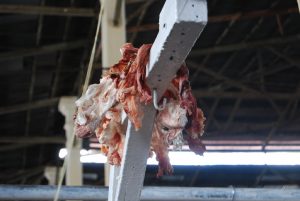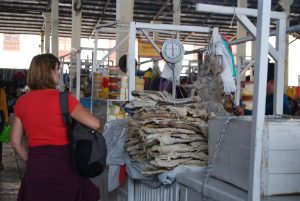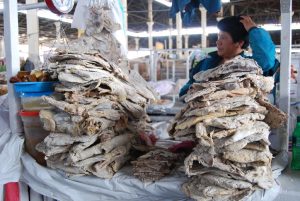Cured Meats, a Tradition and Living Custom in Cuzco

Meat is common in human food, though animals are processed differently in the world various cultures. In this Cuzco has its own traditions of meat which delve deep into the past.
Many tourists visit Cuzco’s San Pedro Market these days. For them the section of meat, with its cuts laying in the open on tiled counters or hanging from hooks–sometimes entire carcasses hang–is surprising. The scents are strong as are the visual images.
A meat department in the US is different, since carcasses and slabs of meat in the open are moved to backstage while vacuumed packed meat is front and center. Generally nowadays the meat is prepackaged and comes from far away. One does not know how old it is, although in the US as a whole there is a preference for aged or cured beef. What we can say is that the meat is definitely not fresh kill.

In Cuzco the slaughterhouses are nearby and the meat is fresh. People consume it shortly after the animal is processed.
However, since the times of the Inca, the people have other ways of processing meat, including salt curing and drying. The word jerky for dried meat comes from the Quechua word charqui and charqui is still used a lot in Cuzco’s cooking.

But there is another word, chalona, which refers to a related but different process that can be like jerky or more akin to the making of corned beef where the meat is cured in a brine solution. Chalona is also common in Cuzco´s cooking.

Just like the processing of potatoes to make chuño or moraya, dark or light freeze dried potatoes, led to products that could be transported and stored for marketing or exchange, so too did the Incas find ways to preserve meat so that it too could be exchanged from one region to another.
Chalona and charqui are two kinds of meats that are easily transportable and were invented long before the advent of refrigerator trucks. Also called cecina, in Spanish, chalona can be made from different meats such as lamb, beef, or pacocha (alpaca). To be made stable for transport, to become chalona, the meat had to go through a curing process.
There are two different processes to make chalona. For both of them people rely on cachi, which in Quechua means salt. In the first layer after layer of the meat is covered with salt until it is completely covered. Then it is dried. In the other a large hole is dug into which water is poured and substantial amounts of salt added. The meat is then submerged in the hole and left for some fifteen days. Then it is taken out and dried.

The chalona is hung on lines or laid out on roofs for the sun and air to work on it. The process of salting the meat is very important since the life of the meat depends on the quality of the salting. It can last for a long time. Brayan’s grandmother says meat made into chalona can last as long as a year.
Today chalona is used a lot and is widely consumed by the people of Cuzco. It is used in many dishes, such as for example, Cuzco’s popular olluquito con charqui. One can also make lentils with charqui and many more dishes.
Chalona is available in Cuzco’s markets and weekly fairs. One can also make ones own chalona using salt.






Very good blog, thank you so much for your time in writing the posts.